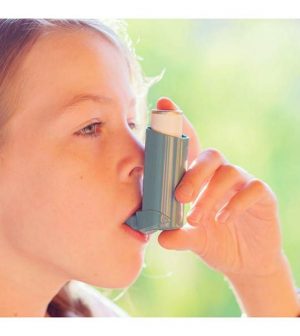- Navigating Your Midlife Crisis: Embracing New Possibilities
- City Raccoons Showing Signs of Domestication
- Mapping the Exposome: Science Broadens Focus to Environmental Disease Triggers
- One Week Less on Social Media Linked to Better Mental Health
- Your Brain Changes in Stages as You Age, Study Finds
- Some Suicide Victims Show No Typical Warning Signs, Study Finds
- ByHeart Formula Faces Lawsuits After Babies Sickened With Botulism
- Switch to Vegan Diet Could Cut Your Greenhouse Gas Emissions in Half
- Regular Bedtime Does Wonders for Blood Pressure
- Dining Alone Could Mean Worse Nutrition for Seniors
A High-Tech Pointer to Pollutants That Trigger Asthma in Kids

Dust mites and smoke are known triggers of asthma in children. Now, scientists have identified previously unknown combinations of air pollutants that appear tied to the respiratory disorder.
“Asthma is one the most prevalent diseases affecting children in the United States. In this study, we developed a list of air pollutants a young child may be exposed to that can lead to longer-term problems with asthma,” said senior study co-author Dr. Supinda Bunyavanich, a professor of pediatrics and genetics and genomic sciences at the Icahn School of Medicine at Mount Sinai in New York City.
“Our results show how breathing individual and combinations of pollutants may lead to poor asthma outcomes. We hope that having a more comprehensive, holistic view of air pollution may one day be able to reduce the chances that children will be burdened by asthma,” Bunyavanich said in a hospital news release.
The team used a machine learning algorithm to assess potential early exposure to dozens of pollutants among 151 children with mild to severe asthma.
While some of those asthma cases were associated with a single, known air pollutant, others seemed connected to mixtures of pollutants never before linked with asthma.
The researchers identified 18 individual chemicals that may be linked to poor asthma outcomes among children. This was defined as requiring daily asthma-controlling medication or having to go to an emergency room or be hospitalized due to asthma.
The investigators also discovered new associations between childhood asthma outcomes and 20 pollutant mixtures. Several of the pollutants in the mixtures had never been linked to long-term asthma risk. The findings were published recently in the Journal of Clinical Investigation.
Asthma affects about 7% of U.S. children, causing them to wheeze and cough. Previous research has shown that exposure to some specific types of air pollution increases a child’s risk of asthma, but the effects of a mixture of pollutants has been unclear.
“Like many scientists, we wanted to provide a more comprehensive picture of how air toxics contribute to childhood asthma,” said senior study co-author Gaurav Pandey, assistant professor of genetics and genomic sciences at Mount Sinai.
“Traditionally, for technical reasons, it has been difficult to study the health effects of more than one toxic at a time. We overcame this by tapping into the power of machine learning algorithms,” Pandey said in the release.
More information
The American Lung Association has more on childhood asthma.
SOURCE: Mount Sinai Hospital, news release, Oct. 7, 2021
Source: HealthDay
Copyright © 2025 HealthDay. All rights reserved.










